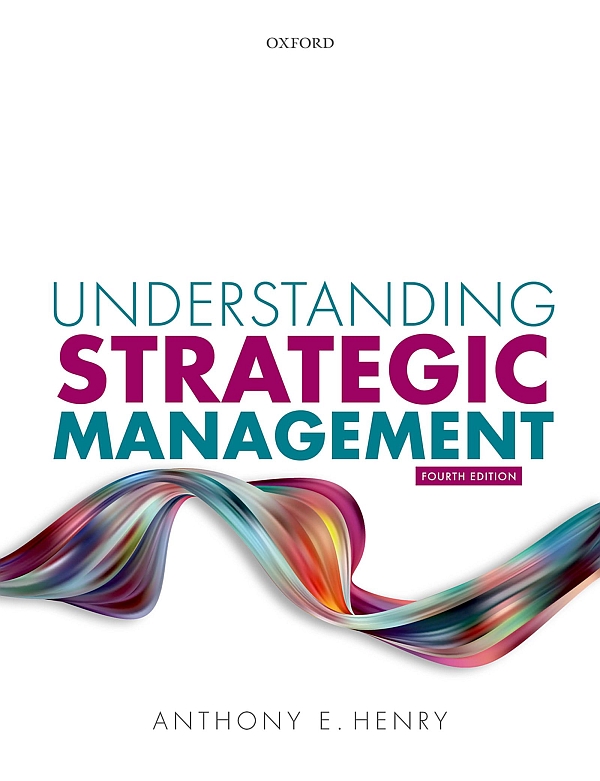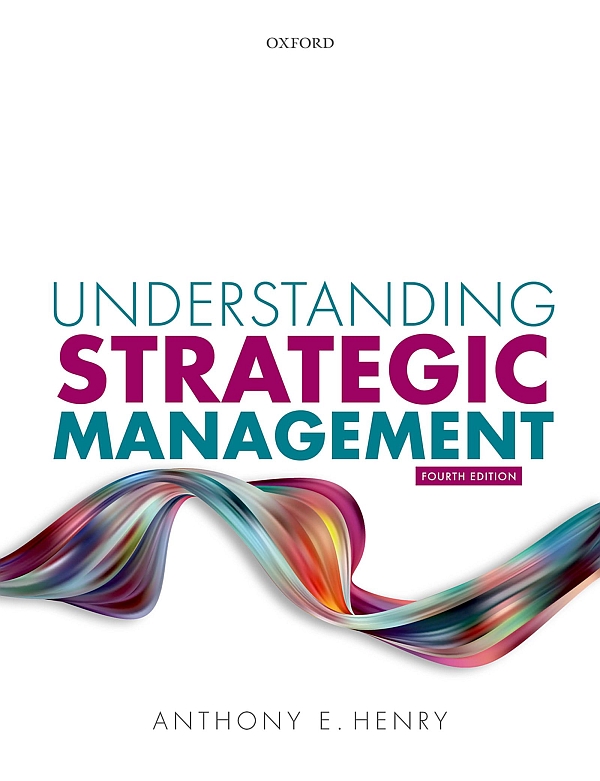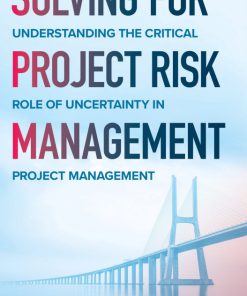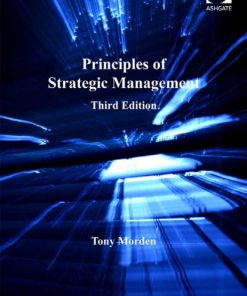(Ebook PDF) Understanding Strategic Management 1st edition by Anthony Henry 0192603639 9780192603630 full chapters
$50.00 Original price was: $50.00.$25.00Current price is: $25.00.
Authors:Henry, Anthony E. , Series:Strategic Studies [124] , Author sort:Henry, Anthony E. , Languages:Languages:eng , Published:Published:Jul 2021 , Publisher:OUP Oxford
Understanding Strategic Management 1st edition by Anthony E. Henry – Ebook PDF Instant Download/DeliveryISBN: 0192603639, 9780192603630
Full download Understanding Strategic Management 1st edition after payment.

Product details:
ISBN-10 : 0192603639
ISBN-13 : 9780192603630
Author : Anthony E. Henry
‘Understanding Strategic Management’ is the ideal introduction to strategy for students who require a concise, informative and practical approach. The book’s four-part structure defines the concept of strategy, before using the overarching strategic framework of analysis, formulation, and implementation to show how strategy can be used to develop a sustainable competitive advantage in business. The author conveys the realities of strategic management through diverse, international and contemporary examples, while Strategy in Focus boxes use examples from popular media to show strategic management issues at work in the headlines we read every day. A longer, integrated case study in every chapter ties together multiple strategic challenges that affect businesses large and small, public and private.
Understanding Strategic Management 1st Table of contents:
Chapter 1 What is Strategy?
Introduction
1.1 What Is Strategy?
1.2 Defining Strategy
1.2.1 Using Strategy to Overcome Challenges
1.3 Types of Strategy
1.3.1 Corporate Strategy
1.3.2 Business Strategy
1.3.3 Functional or Operational Strategy
1.4 Strategic Management
1.4.1 Strategy Analysis
1.4.2 Strategy Formulation
1.4.3 Strategy Implementation
1.5 Values, Vision, and Mission
1.5.1 Values
1.5.2 Vision
1.5.3 Mission
1.6 The Theory of the Business
1.6.1 Four Characteristics of an Organization’s Theory of the Business
1.7 Business Models
1.8 The Development of Strategic Management
1.9 Different Perspectives on Strategy Formulation
1.9.1 The Rationalist School
1.9.2 The Learning School
1.10 A Strategic Management Framework
Summary
Research Topic
Recommended Reading
References and Notes
Part Two Strategic Analysis
Chapter 2 Evaluating the Macro-environment
Introduction
2.1 The Macro-environment
2.2 Scanning, Monitoring, and Forecasting Changes in the Environment
2.2.1 Scanning the Environment
2.2.2 Monitoring the Environment
2.2.3 Forecasting Changes in the Environment
2.3 PESTLE Analysis
2.3.1 Political Factors
2.3.2 Economic Factors
2.3.3 Social Factors
2.3.4 Technological Factors
2.3.5 Legal Factors
2.3.6 Environmental Factors
2.3.7 How to Undertake PESTLE Analysis
2.3.8 Limitations of PESTLE Analysis
2.4 Scenario Planning
2.4.1 How to Build Scenarios
2.5 An Introduction to SWOT Analysis
2.6 The Macro-environment and Industry Analysis
Summary
Research Topics
Recommended Reading
References and Notes
Chapter 3 Industry Analysis
Introduction
3.1 The Background to Porter’s Five Forces Framework
3.2 Porter’s Five Forces Framework
3.2.1 What Determines the Threat of New Entrants
Economies of Scale
Capital Requirements
Product Differentiation
Access to Distribution Channels
Cost Advantages Independent of Size
3.2.2 What Determines the Bargaining Power of Buyers
Concentration of Buyers and High Volumes
Purchases are Standard or Undifferentiated
Switching Costs are Low
There is a Threat of Backward Integration
3.2.3 What Determines the Bargaining Power of Suppliers
Concentration of Suppliers
Suppliers are Faced with Few Substitutes
Differentiated Products and High Switching Costs
Threat of Forward Integration
3.2.4 What Determines the Threat of Substitute Products and Services
The Price–Performance Ratio
3.2.5 What Determines the Intensity of Rivalry among Competitors in an Industry
Numerous or Equally Balanced Competitors
Industry Growth Rate
High Fixed Costs
Lack of Differentiation
High Exit Barriers
3.2.6 How to Compete Using the Five Forces Framework
3.3 The Limitations of Porter’s Five Forces
3.4 The Value Net
3.4.1 A Complementary Sixth Force
3.5 The Industry Life Cycle
3.5.1 Introduction Stage
3.5.2 Growth Stage
3.5.3 Maturity Stage
3.5.4 Decline Stage
3.6 Strategic Group Analysis
3.6.1 Strategic Maps
3.6.2 Mobility Barriers
3.7 Hypercompetition and Disruptive Innovation
3.7.1 Hypercompetition
3.7.2 Disruptive Innovation
Summary
Research Topic
Recommended Reading
References and Notes
Chapter 4 The Organization: Value-creating Activities
Introduction
4.1 Background to Differential Firm Performance
4.2 Value Chain Analysis
4.2.1 Primary Activities
4.2.2 Support Activities
4.3 Evaluating the Value Chain
4.3.1 The Importance of Linkages within the Value Chain
4.3.2 Managing Linkages within the Value Chain System
4.3.3 Transaction Costs—‘Make or Buy’ Decision
4.4 SWOT Analysis
4.4.1 How to Undertake a SWOT Analysis
4.4.2 Limitations of SWOT Analysis
4.5 The TOWS Matrix
4.6 Organizational Performance
4.6.1 Maximizing Shareholder Value
4.6.2 Meeting the Needs of Stakeholders
How Should an Organization Respond to Different Stakeholders?
High Power and High Interest Stakeholders
High Power and Low Interest Stakeholders
Low Power and High Interest Stakeholders
Low Power and Low Interest Stakeholders
4.6.3 Performance Measurement
4.7 The Balanced Scorecard
The balanced scorecard approach looks at an organization from four perspectives.37
Criticisms of the Balanced Scorecard
4.8 The Triple Bottom Line
Limitation of the Triple Bottom Line
4.9 Benchmarking
Summary
Research Topic
Recommended Reading
References and Notes
Chapter 5 The Internal Environment: A Resource-based View of Strategy
Introduction
5.1 The Resource-Based View of Strategy
5.1.1 Resources
Tangible Resources
Intangible Resources
5.1.2 Organizational Capabilities
Architecture
Reputation
Innovation
5.2 The VRIO Framework and Sustainable Competitive Advantage
5.2.1 Valuable Capabilities
5.2.2 Rarity
5.2.3 Imitability
Unique Organizational Conditions
Causal Ambiguity
Social Complexity
5.2.4 Organization
5.2.5 Make-or-Buy Decision
5.3 Criticisms of the Resource-Based View
5.4 A Knowledge-Based View of the Organization
5.5 Dynamic Capabilities
5.5.1 What are Dynamic Capabilities?
5.5.2 Dynamic Capabilities vs Operational Capabilities
5.5.3 Dynamic Capabilities and Competitive Advantage
5.5.4 Challenges for Dynamic Capabilities
Summary
Research Topic
Recommended Reading
References and Notes
Part Three Strategy Formulation
Chapter 6 Business Strategy
Introduction
6.1 What is Business Strategy?
6.2 Generic Competitive Strategies
6.2.1 Overall Cost-Leadership Strategies
The Experience Curve
Economies and Diseconomies of Scale
Advantages of Cost-Leadership Strategies
The Risks of Following an Overall Cost-Leadership Strategy
6.2.2 Differentiation Strategies
Advantages of Differentiation Strategy
Risks of Following a Differentiation Strategy
6.2.3 Focus Strategies
Cost-Focus Strategy
Differentiation-Focus Strategy
Advantages of Focus Strategies
The Risks of Following a Focus Strategy
6.2.4 Stuck in the Middle
Criticisms of Generic Strategies
6.3 A Resource-Based Approach to Strategy Formulation
6.3.1 Appraising Capabilities
6.3.2 Implications for Strategy Formulation
6.4 Blue Ocean Strategy
6.4.1 Value Innovation
6.4.2 The Strategy Canvas
The Four Actions Framework
The Eliminate-Raise-Reduce-Create Grid
6.4.3 The Blue Ocean
Blue Ocean Idea (BOI) Index
6.5 Strategy Formulation in Turbulent Markets
6.6 Disruptive Innovation and Strategy Formulation
6.6.1 How to Respond to Disruptive Innovation
6.6.2 Limitations of Disruptive Innovation
Summary
Research Topic
Recommended Reading
References and Notes
Chapter 7 Corporate Strategy
Introduction
7.1 Corporate Strategy
7.2 Growth Strategies
7.2.1 Market Penetration
7.2.2 Product Development
7.2.3 Market Development
7.2.4 Diversification
7.3 Related Diversification
7.3.1 Vertical Integration
7.3.2 Horizontal Integration
7.3.3 Transaction-Cost Analysis
7.4 Unrelated or Conglomerate Diversification
7.4.1 Can Conglomerate Diversification Succeed?
7.5 Implementing Growth Strategies
7.5.1 Mergers and Acquisitions
7.5.2 Internal Development
7.5.3 Joint Ventures and Strategic Alliances
Joint Ventures
Strategic Alliances
7.6 Portfolio Analysis
7.6.1 Boston Consulting Group Matrix
Criticisms of the BCG Matrix
7.6.2 The General Electric–McKinsey Matrix
7.7 Corporate Parenting
7.7.1 Parenting Opportunities
7.7.2 The Heartland Matrix
Heartland Businesses
Edge-of-Heartland Businesses
Ballast Businesses
Value Trap
Alien Territory
7.8 Strategic Evaluation
7.8.1 Suitability
7.8.2 Feasibility
7.8.3 Acceptability
Summary
Research Topic
Recommended Reading
References and Notes
Chapter 8 International Strategy
Introduction
8.1 Globalization or Localization
8.2 International Diversification
8.2.1 Organizational Factors
The Role of the Management Team
Firm-Specific Factors
8.2.2 Environmental Factors
Unsolicited Proposals
The ‘Bandwagon’ Effect
Attractiveness of the Host Country
8.3 A Globalization Framework
Strategic Objectives of a Multinational Enterprise
Sources of Competitive Advantage for a Multinational Enterprise
8.4 Types of International Strategy
8.4.1 Multidomestic Strategy
8.4.2 Global Strategy
8.4.3 International Strategy
8.4.4 Transnational Strategy
8.4.5 The Uppsala Model
Criticisms of the Uppsala Model
8.5 Entry Mode Strategies
8.5.1 Exporting
8.5.2 Licensing
8.5.3 International Franchising
8.5.4 Joint Ventures and Strategic Alliances
8.5.5 Wholly Owned Subsidiaries
8.6 Porter’s Diamond of National Advantage
8.6.1 The Diamond of National Advantage
8.6.2 Criticisms of Porter’s Diamond
8.7 The Myths of Global Strategy
8.8 The Challenge of Globalization
Summary
Research Topic
Recommended Reading
References and Notes
Part Four Strategy Implementation
Chapter 9 Organizational Structures and Strategic Change
Introduction
9.1 Organizational Structures
9.1.1 The Entrepreneurial Structure
9.1.2 The Functional Structure
9.1.3 The Divisional Structure
9.1.4 The Matrix Structure
9.1.5 The Network Structure
9.2 Organizational Processes
9.3 Strategic Control Systems
9.3.1 Single and Double-Loop Learning
9.3.2 Employee Commitment and Strategy Implementation
9.4 Strategic Change
9.4.1 The Five Phases of Growth
Phase 1: Creativity
Phase 2: Direction
Phase 3: Delegation
Phase 4: Coordination
Phase 5: Collaboration
9.4.2 Integrative Change
9.4.3 Strategic Drift
9.4.4 What Determines a Visionary Organization
9.4.5 Good to Great Companies
Summary
Research Topic
Recommended Reading
References and Notes
Chapter 10 Strategic Leadership
Introduction
10.1 Leadership vs. Management
10.2 The Learning Organization
10.2.1 Building the Learning Organization
10.2.2 Leadership Roles
10.2.3 Leadership Skills
Criticisms of the Learning Organization
10.2.4 Why Organizations Don’t Learn—Problems with Bias
10.3 Emotional Intelligence and Leadership Performance
10.4 Narcissistic Leaders and Leadership Capabilities
10.4.1 Leadership Capabilities
10.5 The Impact of Leadership on Values and Culture
10.5.1 Leadership and Values
10.5.2 Leadership and Culture
10.5.3 Rethinking Culture, Leadership, and Change
10.6 Leading Strategic Change
10.6.1 Transformational Leadership
10.6.2 Theory E and Theory O Leaders
10.6.3 Can Leaders Deal With Chaos?
Chaos Theory and Innovation
Summary
Research Topic
Recommended Reading
References and Notes
Chapter 11 Corporate Governance and Corporate Social Responsibility
Introduction
11.1 What is Corporate Governance?
11.2 The Origins of Corporate Governance
11.3 The Growth of Modern Corporations
11.3.1 Limited Liability
11.3.2 Transferability
11.3.3 Legal Personality
11.3.4 Centralized Management
11.4 The Purpose of Corporations
11.4.1 The Principal–Agent problem
11.4.2 Is the Purpose of Corporations to Maximize Shareholder Value?
The American Business Model (ABM) or Washington Consensus
11.4.3 The Agency Problem
11.4.4 Is the Purpose of Corporations to Meet the Needs of Stakeholders?
11.4.5 Enlightened Value Maximization
11.5 Corporate Social Responsibility (CSR)
11.5.1 Environmental, Social, and Governance (ESG)
11.5.2 Business ethics
11.6 Corporate Governance Codes
11.6.1 The Cadbury Committee
11.6.2 The Hampel Committee
11.6.3 Other Corporate Governance Codes
11.6.4 The Role of Non-Executive Directors
11.6.5 The Sarbanes–Oxley Act
11.7 Excessive Executive Pay
11.8 Is Reform to Corporate Governance the Answer?
11.9 The Pursuit of Greed
11.9.1 Moral Hazard: Are Some Companies Too Big to Fail?
People also search for Understanding Strategic Management 1st:
understanding strategic management 4th edition pdf
understanding strategic management henry
understanding strategic management 4th edition
understanding strategic management process
understanding strategic management book












